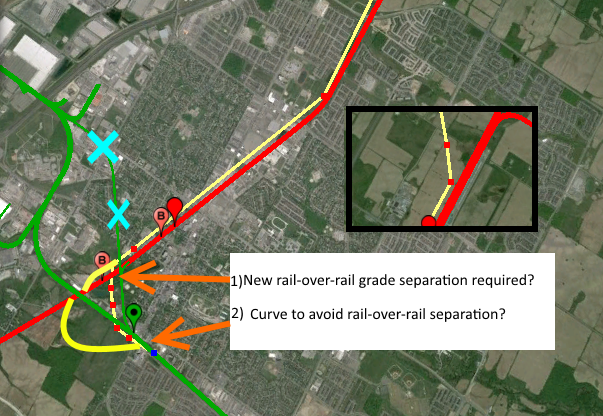Time to separate freight and passenger rail lines
By
Jim Warren, Postmedia Network
First posted: Saturday, August 27, 2016 06:32 PM EDT | Updated: Saturday, August 27, 2016 06:42 PM EDT
Two Canadian Pacific freight trains clipped each other causing a derailment in the Dupont St. and Spadina Rd. area on Aug. 21, 2016. (Dave Thomas/Toronto Sun)
Article
 Report an error
Report an error
The derailment of a freight train in the middle of Toronto last Sunday is an urgent warning for us to rethink how dangerous goods are shipped through the most populated neighbourhoods in Canada.
We need immediate action by the federal government to improve rail safety – action which would also improve public transit.
Quite simply, we need a viable plan to separate freight and passenger rail traffic in Canada.
A plan to keep dangerous goods out of urban centres which would also increase the capacity to run more public transit on existing rail lines in urban centres.
It’s 2016 and our Canadian cities have expanded and grown. More people live closer to freight train lines than ever before.
This same train that derailed in Toronto travelled through Mississauga, Ontario’s third largest city.
In the 1800s railways were used to connect our provinces and cities and allowed us to create a Canada.
Cities used railway trains as the engines of their economies to connect people and products. Major cities expanded through the use of trains.
But in today’s modern digital economy we need those same railway lines to move people within an urban centre and between cities, while keeping freight and dangerous goods outside of the urban core.
Last year there was a plan announced by some local governments to fix this problem but there has yet to be urgent action to make it a reality.
The plan is called the “Missing Link”.
In 2015, the cities of Brampton, Cambridge, Guelph, Milton, Mississauga, Toronto, Kitchener and Waterloo developed a business case for the Missing Link.
It is a new rail corridor to connect two exiting freight lines.
The result removes freight traffic from the southern CP and Canadian National Rail (CN) lines, and diverts it to a freight-only rail line.
Then the existing CN and CP freight lines would be free for more commuter service by GO Transit and VIA Rail.
It is a simple plan -- the Missing Link diverts dangerous freight from many cities while expanding commuter transit.
All-day, two-way electrified GO Train service on the Milton and Kitchener lines would become possible, as would high-speed rail.
This idea is not a new one or unique to Toronto and the Greater Toronto Area. It can be implemented in other urban centres across Canada.
In the 1970s new freight-only rail lines were built north of Toronto.
This was done to increase capacity for passenger lines along the shore of Lake Ontario.
This led to development of the Golden Horseshoe and now the Lakeshore rail line is the busiest passenger rail line in Canada.
Population growth in the biggest cities like Toronto has led to unaffordable housing prices combined with some of the worst traffic in the world.
Government knows this growth will only continue.
Yes, Prime Minister Justin Trudeau has announced an enormous infrastructure program. New programs for subways, street cars and other critical infrastructure will start to follow. Those plans will help.
But gridlock is a growing and complex problem.
And sometimes, the most complex problems can have the simplest solutions.
Mississauga Mayor Bonnie Crombie told me the Missing Link would allow the Ontario government to achieve its vision for Regional Express Rail.
"Dangerous freight would no longer travel through communities, and most importantly, residents could arrive to their destination more quickly and easily.
“The Missing Link is an ambitious project, but one that will fundamentally change how we live and work in the GTA for a generation to come,” said Crombie.
The federal Liberals need to act now to make the best use of existing rail lines to move more people efficiently, while protecting them from potentially dangerous train derailments in the process.
Warren is a Liberal political strategist and media commentator. He worked for former Toronto mayor Mel Lastman and former Ontario premier Dalton McGuinty and is currently a principal at grgadvisors.ca and CEO of Riseley Gaming Inc.








